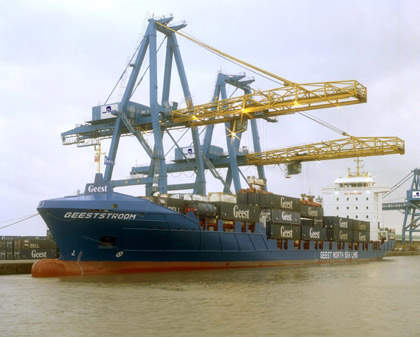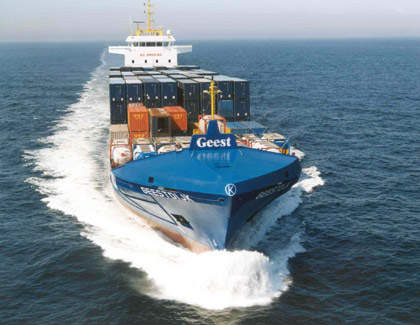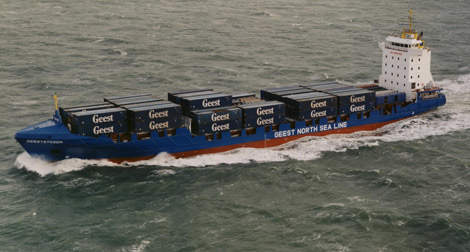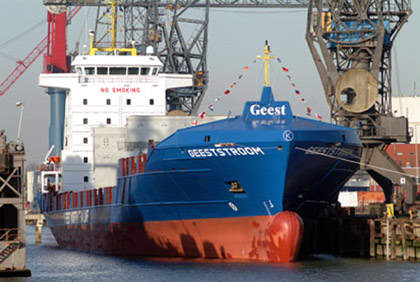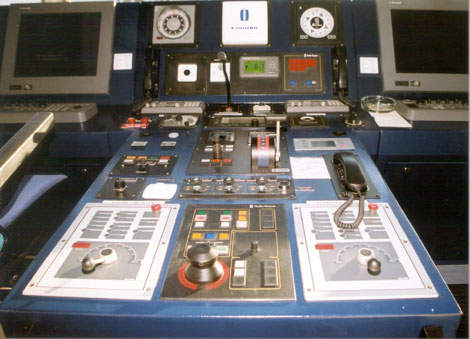The sisterships Geeststroom and Geestdijk were built by Damen Shipyards for Reederi Jorg Kopping of Germany. The new Combi Feeder 800 design was especially developed by the Dutch-based Damen Shipyards Cargo Vessels, to transport 45ft-high cube containers, the largest used on European roads. The designers say that the vessel can also accommodate other sizes of box.
The Geesestroom has a length of 140.64m and a length between perpendiculars of 130m. There is a structural design break on the hull because of the location of the No 1 and No 2 holds. The depth to the main deck is therefore 12.4m forward but only 9.5m amidships.
The ship has a design draught of 7.32m. The hull has a double skin, 1.5m at the bottom and 1.6m at the side. The vessel registers 7,987gt and has a deadweight of 9,400dwt.
The engine runs on heavy fuel oil. The ship’s bunkers store 880m³ of heavy oil and 103m³ of diesel oil. The main engine consumes approximately 36t of fuel a day. The tanks also have a water ballast capacity of 4,587m³.
TEU / FEU CAPACITY
The Geesestroom has a total TEU / FEU capacity of 804 and 361 units respectively. This breaks down to206/97 units in the holds and 598/264 units on the deck. These are arranged in four tiers of seven rows in the holds and seven tiers of eight rows on deck.
The container storage system is particularly versatile. The design means that it can accommodate standard ISO boxes of 2.438m. The cell guides in the holds have been designed by Macgregor. The moveable guides means that the ships can accommodate containers in 20ft, 30ft, 40ft, 45ft, 48ft and 49ft lengths and 8ft, 8ft 6in and 9ft 6in heights. There are also 180 reefer plugs available for refrigerated units.
The hatch covers are Macgregor high-stowing, folding types. These are arranged in 2+2 panel sets and have been designed for a uniformly distributed loading of 1.75t/m². It can accommodate container stack loadings of 60t (20ft units), 70t (30ft units) 90t (40ft units) and 95t (45ft units).
FIRE CONTROL
In case of fire, there is a CO2 extinguishing system in the cargo holds as well as a CO2 / water mist system in the engine room.
ENGINES
The main engine is a MaK 9M43 manufactured by Caterpillar Mak. It has an output of 8,400bhp at 500rpm. This is connected to a Nautilus GUCP 1060 gearbox from Flender. It as an output speed of 40rpm. The shaft is connected to a single propeller, designed and manufactured by Wartsila. The controllable pitch propeller is made from nickel-aluminium-bronze, and has a diameter of 4,900mm.This gives a service speed of 18 knots (90% MCR, 15% sea margin) at a draught of 7.32m. Manoeuvring in port is assisted by a 700kW Wartsila bow thruster and a 500kW stern thruster.
CREW AND BRIDGE
The vessel has a complement of six officers and eight crew, along with four Suez crew. The accommodation and the bridge are at the stern of the vessel. The bridge control system is supplied by Radio Holland. There are two radars, a 2115BB and a 2135SBB supplied by Funuro.
CLASSIFICATION AND NOTATION
The vessels are classified by Germanischer Lloyd with the notation +100A5 E3, +MC E3 AUT IW. It is equipped for Finnish Swedish ice class 1A Container Cargoes in holds and on hatch covers, and fitted for dangerous goods to SOLAS reg:19 II-2 Except class VIII.


